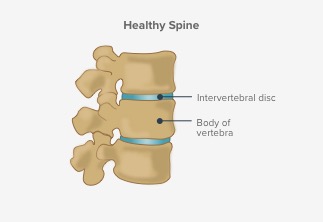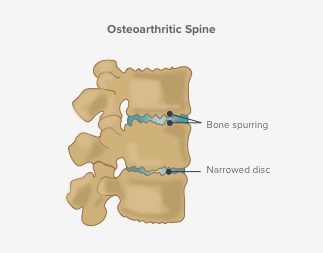Spondylosis (Osteoarthritis of the Spine)
What Is Spondylosis?
Anatomy
Your spine is made up of individual bones called vertebrae, which provide support for the spine. These vertebrae are connected in the front of the spine by intervertebral discs that help support the spine and also allow it to move. The ligaments and muscles that are attached to the back of the spine provide power for movement.
Healthy joints move easily thanks to a smooth, slippery tissue called articular cartilage. Cartilage covers and protects the ends of your bones where they meet to form a joint. When the joint moves, the ends of the bones move along the smooth cartilage instead of grinding against each other.

What is Osteoarthritis
Arthritis means the cartilage in the joints is worn down as a result of wear and tear, injury, or misuse. As the discs dehydrate and shrink, signs of osteoarthritis develop. Osteoarthritis is the most common form of arthritis. This condition includes loss of cartilage and overgrowth of bone.
Once this protective cartilage is gone, the formation of bony projections along the edges of bones (bone spurs) may also develop. This may cause the bones under the cartilage to rub together, causing pain, swelling and loss of motion of the joint. Nerves attached to your spinal cord may have less room to pass between the vertebrae on their way out of the spine.

Spondylosis can cause stiffness and pain in the neck or lower back. Cervical arthritis (also called cervical spondylosis) affects the upper spine and neck. Lumbar (or lumbosacral) arthritis affects the lower back and pelvic area.
Who is at Risk?
Some people are more at risk for developing arthritis than others. The following are factors that may contribute to a person’s risk of developing arthritis.
- Arthritis is more common in patients over the age of 50
- Overused joints from work- or sports-related activities
- Injury or repeated trauma to the bones
- Excessive weight that places stress on joints
- A family history of arthritis
- Smoking
- Women are twice as likely to get arthritis
- Chronic illness such as diabetes, cancer, or liver disease
- A weakened immune system
- Infections such as Lyme disease
Symptoms of Spondylosis
A patient with cervical spondylosis will experience different symptoms than someone with lumbar spondylosis.
Regardless of the location, spondylosis often includes one or more of the following signs and symptoms:
- Intermittent spinal pain
- Spinal stiffness first thing in the morning
- A crunching feeling or sound of bone rubbing on bone
- Spinal deformity a humpback or kyphosis)
- Pain radiating downward into the legs.
- Pain can get worse with activity but improve with rest.
Arthritis in the Neck (Cervical Spondylosis)
A patient with cervical spondylosis may experience:
- Intermittent neck pain, called cervicalgia
- Tenderness, tingling, or numbness in your neck or shoulders
- Pain that radiates from your neck down into your shoulders, arms, or hands
- Limited range of motion and stiffness in your neck
- Headaches, at times more than any other symptom
- Problems maintaining balance
- Difficulty swallowing (which may indicate spinal cord compression)
- Numb, clumsy hands and a difficulty buttoning a shirt or handwriting
Two other types of symptoms that are common in people with arthritis in the neck are:
- Radiculopathy (a disease process that affects the spinal nerve root). Symptoms may include pain, weakness, numbness or electrical sensations down an extremity.
- Myelopathy (compression of the spinal cord) tends to come on over time. It may express itself in a variety of ways, including symptoms associated with radiculopathy, and can also include dizziness.
Mid-Back Arthritis (Thoracic Spondylosis) Symptoms
A patient with thoracic spondylosis may experience:
- Pain localized in your thoracic spine (mid-back)
- Pain that spikes when you bend forward (flexion) and/or backward (extension)
Lumbar (Lower Back) Arthritis (Lumbar Spondylosis)
A patient with lumbar spondylosis may experience:
- Pain, weakness, or numbness in your lower back, legs, or feet
- Limited range of motion in your lower back
- Back pain that eases with rest or after exercising
- Severe leg pain (sciatica)
- Pain or tenderness in your hips, knees, or heels
- Difficulty bending or walking
- Loss of bowel and/or bladder function (which may indicate compresses on the spinal nerve)
Follow Us
Request An Appointment
Address: 3273 Claremont Way, Ste. 201, Napa, CA 94558
Phone: 707-603-1042
